

Abdülmecid I

| Abdulmejid I عبد المجيد اول |
|||||
|---|---|---|---|---|---|
| *Ottoman Caliph Amir al-Mu’minin Sultan of the Ottoman Empire Kayser-i Rûm Custodian of the Two Holy Mosques Knight of the Garter Order of the Tower and Sword* |
|||||
| 31st Ottoman Sultan (Emperor) | |||||
| Reign | 2 July 1839 – 25 June 1861 | ||||
| Predecessor | Mahmud II | ||||
| Successor | Abdülaziz | ||||
| Born | 25 April 1823[1][2] Constantinople,Ottoman Empire |
||||
| Died | 25 June 1861(aged 38) Constantinople, Ottoman Empire |
||||
| Burial |
Yavuz Selim Mosque, Fatih, Istanbul
|
||||
| Consorts | Servetseza Kadın Tirimüjgan Kadın Düzdidil Kadın Şevkefza Kadın Zeynifelek Hanım Gülcemal Kadın Verdicenan Kadın Perestu Kadın Nükhetsezâ Hanım Nesrin Hanım Mahitab Kadın Ceylanyar Hanım Bezmiara Kadın Nergizev Hanım Navekmisal Hanım Nalandil Hanım Şayeste Hanım Serfiraz Hanım Gülüstü Hanım |
||||
| Issue | see below | ||||
|
|||||
| Dynasty | Ottoman | ||||
| Father | Mahmud II | ||||
| Mother | Bezmiâlem Sultan | ||||
| Religion | Sunni Islam | ||||
| Tughra |  |
||||
| Full name | |||||
| Abdul Mecid bin Mahmud | |||||
Abdülmecid I(Ottoman Turkish: عبد المجيد اولAbdülmecîd-i evvel; 23/25 April 1823 – 25 June 1861) orTanzimatçı Sultan Abdülmecid(Sultan Abdülmecid the Reorganizer) due to the Tanzimat reforms he conducted, he is also known asAbdulmejidand similar spellings, was the 31st Sultan of theOttoman Empireand succeeded his father Mahmud II on 2 July 1839.[3]His reign was notable for the rise of nationalist movements within the empire’s territories. Abdulmejid wanted to encourage Ottomanism among the secessionist subject nations and stop the rise of nationalist movements within the empire, but failed to succeed despite trying to integrate non-Muslims and non-Turks more thoroughly into Ottoman society with new laws and reforms. He tried to forge alliances with the major powers of Western Europe, namely theUnited Kingdomand France, who fought alongside the Ottoman Empire in theCrimean WaragainstRussia. In the following Congress of Paris on 30 March 1856, the Ottoman Empire was officially included among the European family of nations. Abdulmejid’s biggest achievement was the announcement and application of the Tanzimat(reorganization)reforms which were prepared by his father and effectively started the modernization of the Ottoman Empire in 1839. For this achievement, one of the Imperial anthems of the Ottoman Empire, the March of Abdulmejid, was named after him.
| Abdulmejid I عبد المجيد اول |
|||||
|---|---|---|---|---|---|
| *Ottoman Caliph Amir al-Mu’minin Sultan of the Ottoman Empire Kayser-i Rûm Custodian of the Two Holy Mosques Knight of the Garter Order of the Tower and Sword* |
|||||
| 31st Ottoman Sultan (Emperor) | |||||
| Reign | 2 July 1839 – 25 June 1861 | ||||
| Predecessor | Mahmud II | ||||
| Successor | Abdülaziz | ||||
| Born | 25 April 1823[1][2] Constantinople,Ottoman Empire |
||||
| Died | 25 June 1861(aged 38) Constantinople, Ottoman Empire |
||||
| Burial |
Yavuz Selim Mosque, Fatih, Istanbul
|
||||
| Consorts | Servetseza Kadın Tirimüjgan Kadın Düzdidil Kadın Şevkefza Kadın Zeynifelek Hanım Gülcemal Kadın Verdicenan Kadın Perestu Kadın Nükhetsezâ Hanım Nesrin Hanım Mahitab Kadın Ceylanyar Hanım Bezmiara Kadın Nergizev Hanım Navekmisal Hanım Nalandil Hanım Şayeste Hanım Serfiraz Hanım Gülüstü Hanım |
||||
| Issue | see below | ||||
|
|||||
| Dynasty | Ottoman | ||||
| Father | Mahmud II | ||||
| Mother | Bezmiâlem Sultan | ||||
| Religion | Sunni Islam | ||||
| Tughra |  |
||||
| Full name | |||||
| Abdul Mecid bin Mahmud | |||||
Early life
Abdulmejid received a European education and spoke fluentFrench, the first sultan to do so.[1]Like Abdülaziz who succeeded him, he was interested in literature and classical music. Like his father Mahmud II, he was an advocate of reforms and was lucky enough to have the support of progressive viziers such as Mustafa Reşit Pasha, Mehmet Emin Ali Paşa and Fuad Pasha. Throughout his reign he had to struggle against conservatives who opposed his reforms. Abdulmejid was also the first sultan to directly listen to the public’s complaints on special reception days, which were usually held every Friday without any middlemen. Abdulmejid toured the empire’s territories to see in person how the Tanzimat reforms were being applied. He travelled to İzmit, Mudanya, Bursa, Gallipoli, Çanakkale, Lemnos, Lesbos and Chios in 1844 and toured the Balkan provinces in 1846.
Reign
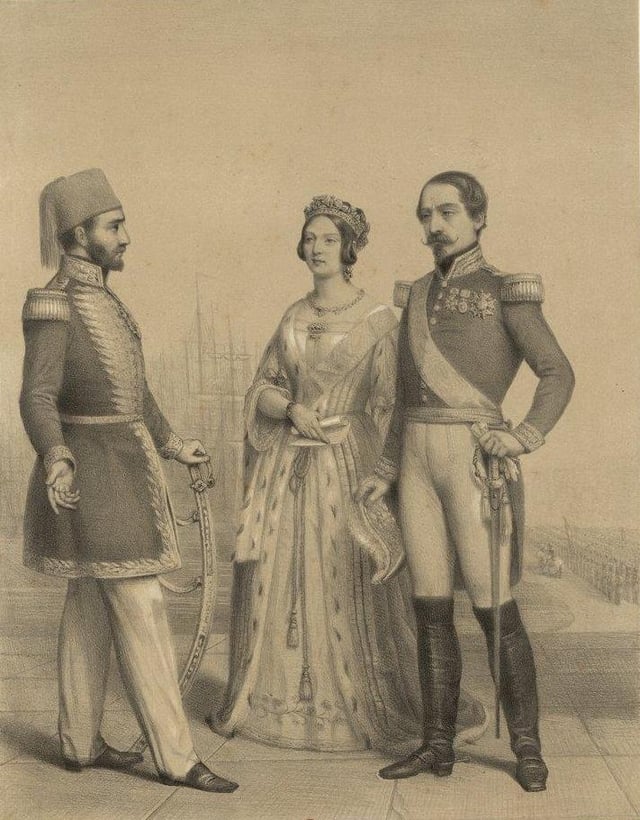
Sultan Abdulmejid (left) withQueen Victoriaof theUnited Kingdomand Emperor Napoleon III of France
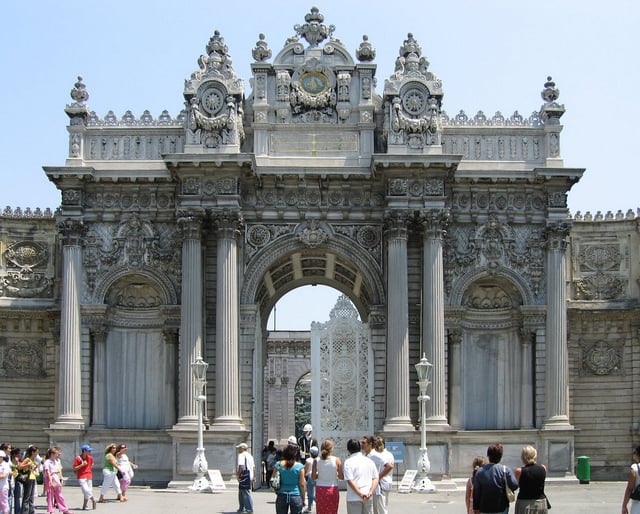
Dolmabahçe Palace, the first European-style palace in Istanbul, was built by Abdulmejid between 1843 and 1856, at a cost of five million Ottoman gold pounds, the equivalent of 35 tons of gold. Fourteen tons of gold was used to adorn the interior ceiling of the palace. The world’s largest Bohemian crystal chandelier, a gift fromQueen Victoria, is in the centre hall. The palace has the largest collection of Bohemian and Baccarat crystal chandeliers in the world, and even the staircases are made of Baccarat crystal.
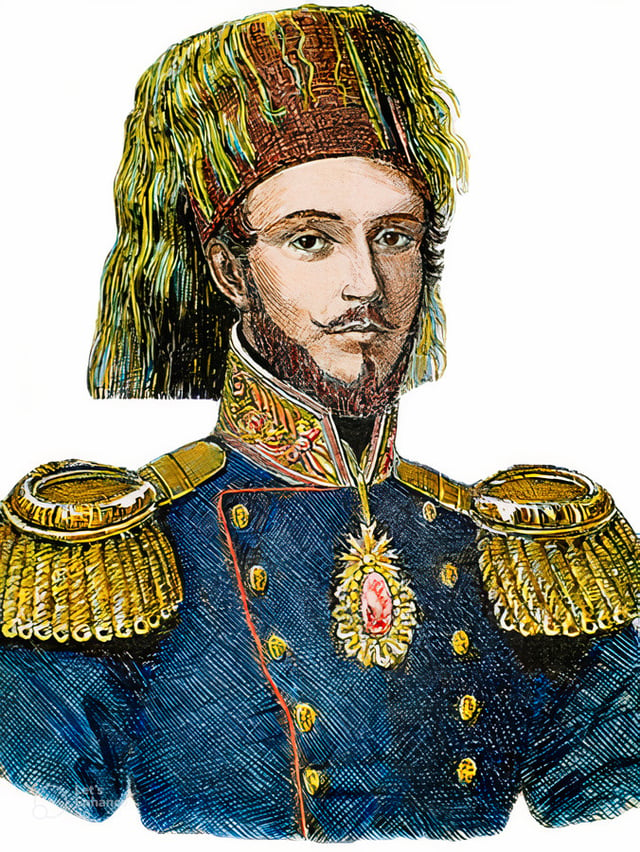
During the reign of Abdulmejid, besides European style architecture and European style clothing adopted by the court, the Ottoman educational system was also mainly based on the European model.
When Abdulmejid succeeded to the throne, the affairs of theOttoman Empirewere in a critical state. At the time his father died, the news reached Istanbul that the empire’s army had been defeated at Nizip by the army of the rebel Egyptian viceroy,Muhammad Ali. At the same time, the empire’s fleet was on its way toAlexandria, where it was handed over to Muhammad Ali by its commander Ahmed Fevzi Pasha, on the pretext that the young sultan’s advisers had sided with Russia. However, through the intervention of the European powers, Muhammad Ali was obliged to come to terms, and the Ottoman Empire was saved from further attacks while its territories in Syria, Lebanon and Palestine were restored. The terms were finalised at the Convention of London (1840).[1]
In compliance with his father’s express instructions, Abdulmejid immediately carried out the reforms to which Mahmud II had devoted himself. In November 1839 an edict known as theHatt-ı Şerif of Gülhane, also known as Tanzimat Fermanı was proclaimed, consolidating and enforcing these reforms. The edict was supplemented at the close of theCrimean Warby a similar statute issued in February 1856, named the Hatt-ı Hümayun. By these enactments it was provided that all classes of the sultan’s subjects should have their lives and property protected; that taxes should be fairly imposed and justice impartially administered; and that all should have full religious liberty and equal civil rights. The scheme met with strong opposition from the Muslim governing classes and theulema,or religious authorities, and was only partially implemented, especially in the remoter parts of the empire. More than one conspiracy was formed against the sultan’s life on account of it.[9]
The most important reform measures promoted by Abdulmejid were:
-
Introduction of the first Ottoman paper banknotes (1840)
-
Reorganisation of the army, including the introduction of conscription (1842–1844)[1]
-
Adoption of an Ottoman national anthem and Ottoman national flag (1844)
-
Reorganisation of the finance system according to the French model
-
Reorganisation of the Civil and Criminal Code according to the French model[1]
-
Reorganisation of the court system, establishing a system of civil and criminal courts with both European and Ottoman judges.[1]
-
Establishment of theMeclis-i Maarif-i Umumiye(1845) which was the prototype of the First Ottoman Parliament (1876)
-
Institution of a council of public instruction (1846)
-
Creation of the Ministry of Education[1]
-
Plans to send humanitarian aid of£10,000[10](£1,028,827.55 in 2019[11]) to Ireland during its Great Famine, but later agreed to reduce it to £1,000[10](£2.483 million in 2013[12]) at the insistence of British diplomats wishing to avoid embarrassingQueen Victoria, who had made a donation of £2,000.[10]
-
Plans to abolish slave markets (1847)[10]
-
Plans to build a Proant chapel (1847)[10]
-
Establishment of modern universities and academies (1848)
-
Establishment of an Ottoman school in Paris[1]
-
Abolition of a capitation tax which imposed higher tariffs on non-Muslims (1856)
-
Non-Muslims were allowed to become soldiers in the Ottoman army (1856)
-
Various provisions for the better administration of the public service and for the advancement of commerce[9]
-
New land laws confirming the right of ownership (1858)[1]
Another notable reform was that the turban was officially outlawed for the first time during Abdulmejid’s reign, in favour of the fez. European fashions were also adopted by the Court. (The fez would be banned in 1925 by the same Republican National Assembly that abolished the sultanate and proclaimed the Turkish Republic in 1923).
Samuel Morsereceived his first ever patent for the telegraph in 1847, at the old Beylerbeyi Palace (the present Beylerbeyi Palace was built in 1861–1865 on the same location) in Istanbul, which was issued by Sultan Abulmejid who personally ed the new invention.[15]
When Kossuth and others sought refuge in Turkey after the failure of the Hungarian uprising in 1849, the sultan was called on byAustriaandRussiato surrender them, but he refused.[1]He also would not allow the conspirators against his own life to be put to death. The1911Encyclopædia Britannicasays of him, “He bore the character of being a kind and honourable man, if somewhat weak and easily led. Against this, however, must be set down his excessive extravagance, especially towards the end of his life.”[9]
In 1844 he created the Ottoman lira and in 1852 he instituted the Order of the Medjidie.
The Ottoman Empire received the first of its foreign loans on 25 August 1854 during theCrimean War. This major foreign loan was followed by those of 1855, 1858 and 1860, which culminated in default and led to the alienation of European sympathy from the Ottoman Empire and indirectly to the later dethronement and death of Abdulmejid’s brother Abdülaziz.[9]
His success in foreign relations was not as notable as his domestic accomplishments. His reign started off with the defeat of his forces by the Viceroy of Egypt and the subsequent signing of the Convention of London (1840), which saved his empire from a greater embarrassment. The Ottomans successfully participated in the Crimean War and were winning signatories at the Treaty of Paris (1856). His attempts at strengthening his base in theBalkansfailed in Bosnia andMontenegro, and in 1861 he was forced to give upLebanonby the Concert of Europe.[1]
He restored the Hagia Sophia between 1847 and 1849, and was responsible for the construction of theDolmabahçe Palace. He also founded the first French Theatre in Istanbul.[1]
He was made the 717th Knight of theOrder of the Garterin 1856 and the 52nd Grand Cross of the Order of the Tower and Sword.
Death
Abdulmejid died oftuberculosis(like his father) at the age of 38 on 25 June 1861 in Istanbul, and was buried in Yavuz Selim Mosque, and was succeeded by his younger half-brother Sultan Abdülaziz, son of Pertevniyal Sultan.
Family
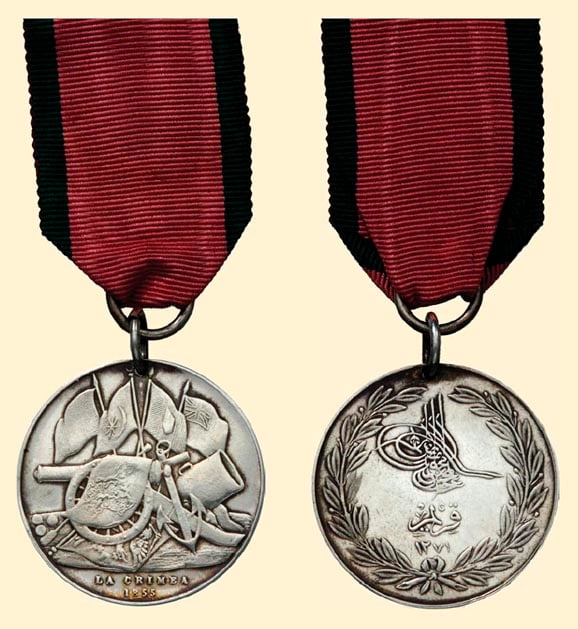
The Crimean War medal issued by Abdulmejid to British, French and Sardinian allied personnel involved in theCrimean War(Sardinian issue)
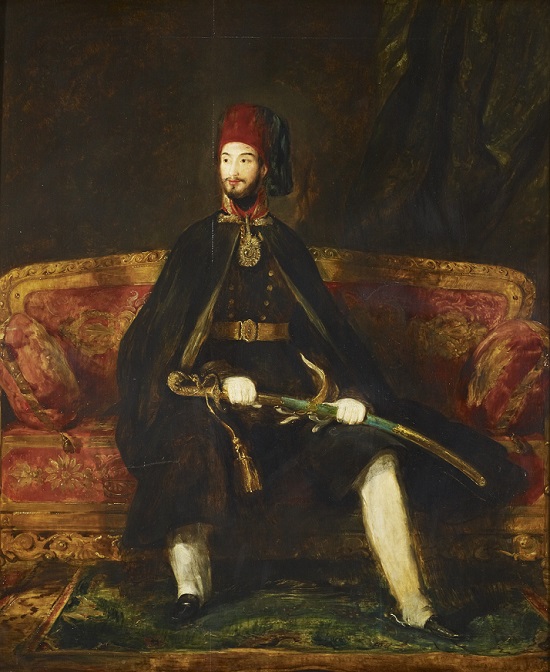
Abdulmejid in his youth, by David Wilkie, 1840.
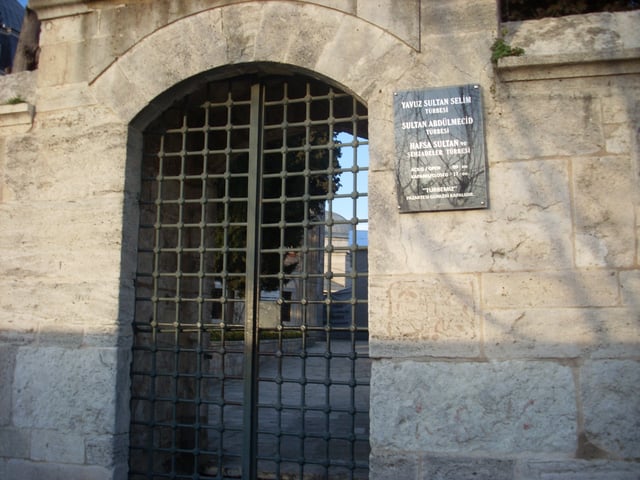
The türbe of Abdulmejid is located inside the Yavuz Selim Mosque in Fatih, Istanbul.
Abdulmejid married nineteen times and had forty-four children. He left several sons, of whom four eventually succeeded to the throne. His marriages were:
-
Circassian(of the Kabardian tribe) Servetseza Kadın (c. 1823, Maykop, Russia – 24 September 1878, Kabataş Palace, Istanbul), married in Istanbul, Topkapı Palace, in 1839, daughter of Prince Mansur Bey Temruko and Princess Fülane Hanım Dadeşkeliani, without issue.[16]
-
Circassian (of the Shapsug tribe) Tirimüjgan Kadın (c. 1823 – Istanbul, Feriye Palace, 3 October 1852), married in Istanbul, Topkapı Palace, in 1839, daughter of Bekhan Bey and Almaş Hanım, and had: Naime Sultan (11 October 1840 – 1 May 1843, buried in Laleli türbesi); Sultan Mehmed Abdul Hamid II, 34th Sultan of theOttoman Empire; Şehzade Mehmed Abid (22 April 1848 – 7 May 1848, buried in New Mosque – Refia Sultan türbesi);
-
Circassian (of the Ubykh tribe) Düzdidil Kadın (née Ayşe Dişan, c. 1824, North Caucasus – 18 August 1845, Old Çırağan Palace, Istanbul), married in Istanbul, Topkapı Palace, in 1839, daughter of Şıhım Bey Dişan and Princess Fülane Hanım Çaçba, and had: Mevhibe Sultan (31 May 1840 – 9 February 1841, buried in Bahçekapı, Hamidiye Türbesi); Neyyire Sultan (13 October 1841 – 18 December 1843); Münire Sultan (13 October 1841 – 18 December 1843); Cemile Sultan (Old Beylerbeyi Palace, Bosphorus, 17 August 1843 – Erenköy, 26 February 1915); Samiye Sultan (23 February 1845 – 18 April 1845, buried in New Mosque, Istanbul);
-
Circassian(of the Ubykh[17]tribe who temporarily sought refuge in present-day Georgia) Şevkefza Valide Sultan, (c. 1824, Poti, Georgia – 17 September 1889, Istanbul, Ortaköy, Çırağan Palace), married in Istanbul, Topkapı Palace, in 1839, daughter of Mehmed Bey Zaurum and Cemile Hanım, and had: Sultan Mehmed Murad V, 33rd Sultan of theOttoman Empire; Aliye Sultan (20 October 1842 – 10 July 1845, buried in New Mosque);
-
Abkhazian Zeynifelek Hanım (c. 1824, North Caucasus – Old Çırağan Palace, Istanbul, December 1841), married in Istanbul in 1839, daughter of Prince Aslan Bey Klıç and Princess Şaşa Hanım Loo, and had: Behiye Sultan (22 February 1841 – 3 June 1847).
-
Bosniak[18]Gülcemal Kadın, (Caucasus, c. 1825 – Istanbul, Ortaköy, Ortaköy Palace, 16 November 1851), married in Istanbul, Topkapı Palace, in 1840 and had: Fatma Sultan (1 November 1840 – 26 August 1884); Refia Sultan (Beşiktaş Palace, 7 February 1842 – Defterdarburnu Palace, 4 January 1880); Sultan Mehmed V Reşad, 35th Sultan of theOttoman Empire;
-
Abkhazian Verdicenan Kadın (née Saliha Açba, c. 1829, Sukhumi, Abkhazia – 9 December 1889, Istanbul,Beşiktaş, Beşiktaş Palace), married in Istanbul, Topkapı Palace, in 1844, daughter of Prince Kaytuk Giorgi Bey Açba and Princess Yelizaveta Hanım, and had: Münire Sultan (daughter of Abdulmejid I) (Topkapı Palace, Istanbul, 9 December 1844 – Istanbul, 29 June 1862); Şehzade Ahmed Kemaleddin (Old Çırağan Palace, Istanbul, 3 December 1847 – Beşiktaş Palace, Istanbul, 26 April 1905);
-
Circassian(of the Ubykh tribe) Rahime Perestu Valide Sultan (née Rahime Gogen, c. 1829, Sochi, Russia – Maçka Palace, Istanbul), married in Istanbul, Topkapı Palace, in 1844, daughter of Gök Bey Gogen, without issue.[16]Adoptive mother and Valide Sultan to Abdul Hamid II.
-
Abkhazian Nükhetsezâ Hanım (née Hatice Baras, Abkhazia,Russian Empire, c. 1830 –Beşiktaş, 15 May 1850), married in Istanbul, Topkapı Palace, in 1845, daughter of Hatuğ Bey Baras and Ferhunde Hanım, and had:[16]Şehzade Ahmed (5 June 1846 – 6 June 1846); Nazime Sultan (26 November 1847 – 1 December 1847, buried in New Mosque – Refia Sultan türbesi); Şehzade Mehmed Burhaneddin (Old Beylerbeyi Palace, Bosphorus, 23 May 1849 –Dolmabahçe Palace, Istanbul, 4 November 1876);
-
Chechen Mahitab Kadın (née Nuriye, c. 1832, Makhachkala, Russia – c. 1888, Feriye Palace, Istanbul), married in Istanbul, Topkapı Palace, in 1845, daughter of Hişam Bey and Malika Hanım, and had: Sabiha Sultan (15 April 1848 – 27 April 1849); Şehzade Ahmed Nureddin (Çırağan Palace, 31 March 1852 – 3 January 1884); Zekiye Sultan (24 February 1855 – 18 February 1856); Fehime Sultan (24 February 1855 – 10 November 1856);
-
Georgian Nesrin Hanım (née Adile Asemiani, c. 1832, Poti, Georgia – 2 January 1853, Istanbul), married in Istanbul, Topkapı Palace, in 1846, daughter of Manuçar Bey Asemiani and Mahra Hanım, and had: Şehzade Mehmed Ziyaeddin (22 November 1846 – 27 April 1849); Behice Sultan (26 August 1848 – 21 December 1876); Şehzade Mehmed Bahaeddin (24 June 1850 – 9 November 1852); Şehzade Mehmed Nizameddin (24 June 1850 – 9 November 1852);
-
Circassian (of the Natukhai tribe) Nergizev Hanım (c. 1832, Anapa, Russia – Istanbul, 26 October 1848), married in Istanbul, Topkapı Palace, in 1847, daughter of Albora Bey and Dadüse Hanım, and had: Şehzade Mehmed Fuad (7 July 1848 – 28 September 1848);
-
CircassianBezmiara Kadın, married in Istanbul, Topkapı Palace, in 1847 and divorced in 1859, and had: Mukbile Sultan (22 February 1850 – 10 March 1850, buried in New Mosque – Refia Sultan türbesi);
-
Circassian(of the Natukhai tribe) Nalandil Hanım (born c. 1835,Caucasus), married in Istanbul, Topkapı Palace, in 1851, daughter of Prince Natıkhu Bey Çıpakue, and had: Seniha Sultan (Çırağan Palace, 21 December 1851 – Nice,France, 15 September 1931); Şehzade Mehmed Abdüssamed (20 March 1853 – 5 May 1855); Şehime Sultan (Old Beşiktaş Palace 31 January 1855 – 22 May 1857);
-
Circassian(of the Ubykh tribe) Ceylanyar Hanım (née Nafiye Berzeg, c. 1836, Sochi, Russia – 23 April 1856, Feriye Palace, Istanbul), married in Istanbul, Topkapı Palace, in 1851, daughter of Mustafa Bey Berzeg and Princess Daruhan Hanım Dudaruk, and had: Şehzade Mehmed Rüşdü (31 March 1852 – 5 August 1852);
-
Abkhazian Serfiraz Hanım (née Ayșe Liah, c. 1836 Abkhazia – 9 June 1905, Istanbul, Ortaköy, Ortaköy Palace), married in Istanbul, Topkapı Palace, in 1851, daughter of Prince Osman Bey Liah and Zeliha Hanım Tapsın, and had: Şehzade Osman Safiyeddin Efendi (9 June 1852 – 2 July 1855); Bedia Sultan (October 1857 – 12 July 1858); Şehzade Selim Süleyman (Beşiktaş, 25 July 1860 – Bebek Palace, Bosphorus, 16 June 1909), married and had issue;
-
Abkhazian Şayeste Hanım (c. 1837 Sukhumi, Abkhazia – 11 February 1912, Istanbul), married in Istanbul, Topkapı Palace, in 1852, daughter of Prince Tataş Bey İnalipa and Sarey Hanım, and had: A son (3 February 1853 – 3 February 1853); Naile Sultan (Dolmabahçe Palace, Istanbul, 30 September 1856 – 18 January 1882), married at the Dolmabahçe Palace, Istanbul, 6 October 1876, Damat Mehmed Pasha (died 24 May 1909), 1st ADC to Abdul Hamid II;
-
Abkhazian Navekmisal Hanım (c. 1838, North Caucasus – 5 August 1854, Şemsipaşa Palace, Istanbul), married in Istanbul, Topkapı Palace, in 1853, daughter of Prince Rustem Bey Biberd and Princess Fatma Hanım Kızılbek, without issue.[16]
-
Abkhazian Gülüstü Hanım (née Fatma Çaçba, c. 1840 – c. 1865, Eyüp Palace, Istanbul), married in Istanbul, Topkapı Palace, in 1855, daughter of Prince Tahir Bey Çaçba and Afişe Hanım Lakerba, and had:[16]Mediha Sultan (Beşiktaş, 31 July 1856 – Nice,France, 7 November 1928);Sultan Mehmed VI Vahideddin, last Sultan of theOttoman Empire;
-
The mothers of following children are unknown. Şehzade Mehmed Vamik (19 April 1849 – 6 August 1849, buried in New Mosque – Refia Sultan türbesi); Fülane Sultan (16 December 1858 – 16 December 1858); Fülane Sultan (30 May 1860 – 30 May 1860);
In fiction
-
A fictionalized version of Abdulmejid I appears in the 2008 novelThe Bellini Card, by Jason Goodwin.[19]